Now that Telehealth is a part of medical and audiology practice, it is essential for patients to hear and understand the information presented by their healthcare providers. Typical headphones, microphones and Air Pods used to communicate for Telehealth, ZOOM, Go To Meeting, Skype, etc., are simple devices that do not offer compensation for hearing loss.
The team at EVEN is a passionate group of scientists, engineers, and creatives based in Brooklyn, New York. The EVEN Headphone/Microphone team began pioneering the first direct-to-consumer headphone/microphone with a patented voice-assisted “hearing check” in 2016. Their technology, called an EarPrint, now in its 5th generation, estimates the users hearing loss from the patented EarPrint process and amplifies any input signal, such as music or speech according to the user’s unique hearing profile. Created with 21st-century innovative engineering and the input of audiological science, the EVEN Headphone/Microphone was recognized as a winner of the Popular Science 100 Greatest Invention Awards.
For music, the device is recommended by the likes of Rod Stewart and Mick Fleetwood of Fleetwood Mac for musical enjoyment with gentle amplification compensation for mild to moderate hearing losses. The use of EVEN for Telehealth makes speech is easier to hear, clearer and better understood when communicating with a physician or health care provider.
Patented EarPrint Technology
 Once the EarPrint is established, the EVEN device uses the data to set up a customized amplification program that compensates for a user’s specific hearing deficit. For consumers, obtaining an EarPrint is a simple process assisted by Sara, a voice that takes the user through the procedure. The EarPrint process is simply accessed by the white EVEN button located on the left ear cup. A double tap on this button puts the device into the EarPrint mode. Once in the EarPrint mode, Sara takes over and begins obtaining the EarPrint with the right ear, presenting the frequencies of 125 Hz-14,000 Hz one by one.
Once the EarPrint is established, the EVEN device uses the data to set up a customized amplification program that compensates for a user’s specific hearing deficit. For consumers, obtaining an EarPrint is a simple process assisted by Sara, a voice that takes the user through the procedure. The EarPrint process is simply accessed by the white EVEN button located on the left ear cup. A double tap on this button puts the device into the EarPrint mode. Once in the EarPrint mode, Sara takes over and begins obtaining the EarPrint with the right ear, presenting the frequencies of 125 Hz-14,000 Hz one by one.
When the tone is heard, the user does a single press on the white button and the threshold for that frequency is stored in the device. When all the frequencies for the right ear are completed, Sara takes the user through the same process for the left ear storing each of those thresholds as the EarPrint for both ears. Based upon the stored thresholds a unique gentle amplification of the input signal is created for a mild to moderate hearing loss.
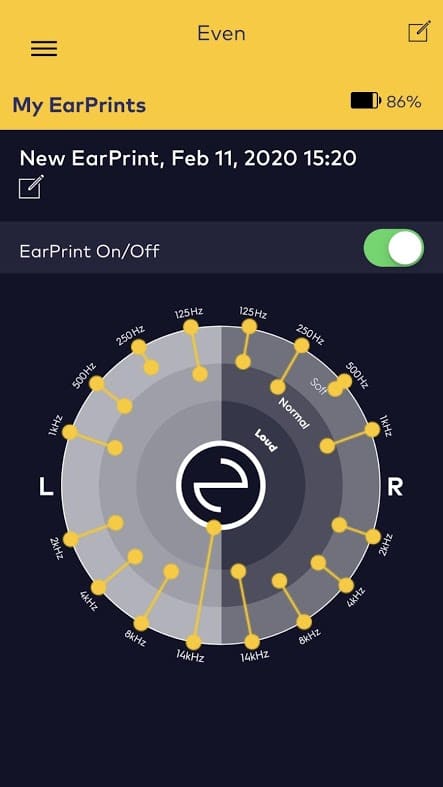 For those used accustom to smartphone apps, the EarPrint may also be conducted with a smartphone application, easily installed from either the Apple App Store or the Android Play Store. Once downloaded, the user accesses the EarPrint application from the menu and Sara begins the same process to establish an EarPrint. An advantage of using the smartphone app is that the user may store multiple EarPrints for use in many different situations, such as airplanes, different types of music, or for special hard to hear voices.
For those used accustom to smartphone apps, the EarPrint may also be conducted with a smartphone application, easily installed from either the Apple App Store or the Android Play Store. Once downloaded, the user accesses the EarPrint application from the menu and Sara begins the same process to establish an EarPrint. An advantage of using the smartphone app is that the user may store multiple EarPrints for use in many different situations, such as airplanes, different types of music, or for special hard to hear voices.
Of course, like most of the non-audiometric hearing tests, EarPrints are not the same as a hearing evaluation conducted by an audiologist, due to many factors. Recognizing this issue as a concern for the EarPrint, the EVEN engineers, with the advice of hearing scientists and audiologists, worked through various models of their product to refine the EarPrint signal and Sara’s assessment process.
This is Cool But Show Me the Data…
Generally, audiologists are skeptical of hearing checks and assessments conducted outside of a clinical environment as there are variances in the transducers, testing environments, instructions to patients and psychoacoustical variables that pollute nonclinical hearing test data. Further complications would also include the subjective-interactive nature of self-hearing assessment.
To reduce this apprehension, The EVEN executives commissioned studies at the University of the Pacific Audiology Clinic, San Francisco, California and the University of Buffalo, Buffalo, New York. According to Hu (2020) the studies were conducted by Inouye et al (2018), Campa et al (2019), Inouye & Hu (2019) and Wolfram et al (2020) to compare the accuracy of Sara’s automated, self-administered EarPrint and a formal audiological assessment of hearing by an audiologist in a clinical environment.
While the EarPrint “hearing check” evaluates up to 14k Hz, this frequency is not routinely tested in most audiology clinics, therefore, the studies only reviewed the agreement of these assessments at 250, 500, 1k, 2k, 4k and 8 kHz. It also seemed that although overall testing accuracy and consistency are good across frequency for both ears, the lower frequencies seem to have smaller variations. Specifically, at 250, 500, and 1k Hz, the difference between the conventional audiogram and EarPrint is +/- 5 dB, which is the typical test-retest reliability range of conventional audiological testing. Variability is greater at higher frequencies, with the means generally at 10-15 dB with a range of up to 20 dB (See Figure 1).
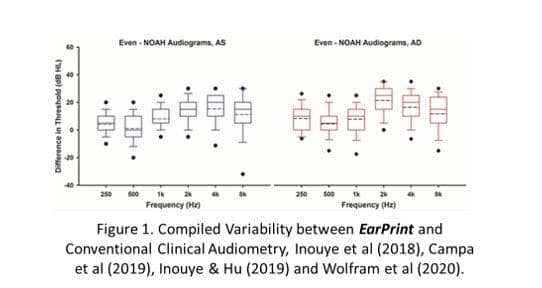
The specific frequency differences of the compilation of data are presented in Figure 2. Scatterplots of the data specifics demonstrate a high correlation between the two assessments. See Figure 2 (below).
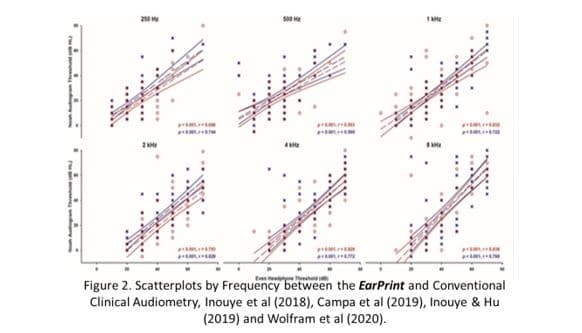
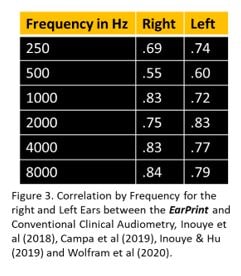 The specific correlations are presented in Figure 3. All frequencies in both ears revealed strong and significant (p < 0.001) correlations between EarPrint thresholds and conventional audiograms. Suggesting that the correlation is good enough between the two measurements to facilitate a reasonable facsimile of a gentle amplification compensation over the frequency spectrum.
The specific correlations are presented in Figure 3. All frequencies in both ears revealed strong and significant (p < 0.001) correlations between EarPrint thresholds and conventional audiograms. Suggesting that the correlation is good enough between the two measurements to facilitate a reasonable facsimile of a gentle amplification compensation over the frequency spectrum.
While the correlations between the EarPrint and an in-clinic conventional audiological assessment are strong, the studies suggested that patients with hearing losses greater than 70 dB on the conventional audiogram is that patients with hearing loss at this level could not reliably hear the EarPrint sound prompts from Sara. Thus, at least in these studies, patients with a loss at and above 70 dB HL on the audiogram at different frequencies did not hear much difference in the performance of the EVEN device. Simply reviewing the differences between EarPrints and conventional audiometry plotted as audiograms suggest the minimal differences noted in the correlations.
Figure 4 presents the similarity of these conventional and EarPrint audiograms.
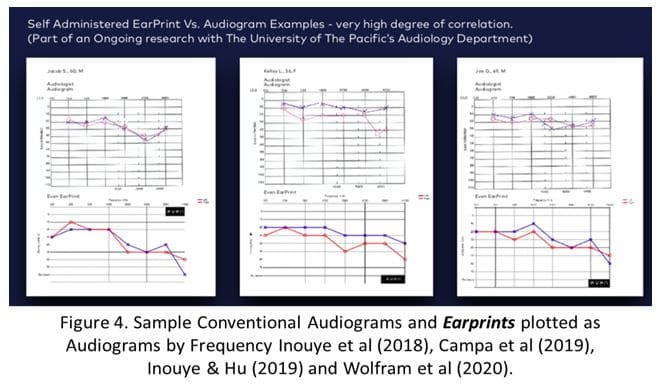
The conclusion of the research was, basically, that the Sara-assisted, self-administered EarPrint is close and reliable enough to generate an estimation of the listener’s hearing and provide gentle amplification signal to accommodate mild to moderate hearing losses when listening to music or attempting to understand speech during Telehealth, Zoom or other communication meeting conversations.
An added benefit to the EVEN device is that multiple EarPrints may be made and stored in the EVEN EarPrint phone app for various situations, such as music, speech, airplanes, or other unique situations.
How Does this Help my Practice?
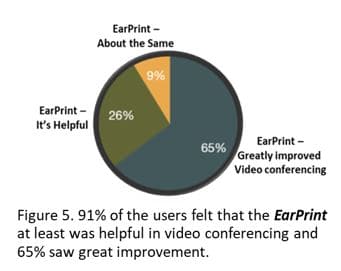 As an audiologist, and former practice owner for 40 years, this is a classic example of differentiation by product (Traynor 2020) and the perfect headphone/microphone to conduct Telehealth, Zoom, or other computer conferencing for work or with family and friends. In April 2020, a survey of 90 EVEN Headphone/Microphone users that incorporated the device videoconferencing at work and home with relatives and friends, 91% found of the respondents
As an audiologist, and former practice owner for 40 years, this is a classic example of differentiation by product (Traynor 2020) and the perfect headphone/microphone to conduct Telehealth, Zoom, or other computer conferencing for work or with family and friends. In April 2020, a survey of 90 EVEN Headphone/Microphone users that incorporated the device videoconferencing at work and home with relatives and friends, 91% found of the respondents
that, compared to other headphone/microphone systems, the EarPrint was at least helpful for their video conferencing and 65% saw great improvement. See Figure 5. Respondents were also asked to compare the EVEN Headphone/Microphone to other communication devices they have used in the past. While 31% of the group did not see much difference between the EVEN device and other systems, an overwhelming 69% of the respondents felt the
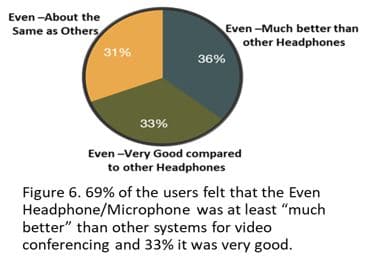 EVEN device was at least much better than other systems they had used and 33% felt it was very good in comparison. See Figure 6. One comment from the survey was “I love the EarPrint technology because I wear Hearing Aids and these headphones pretty much duplicate them, No more muddy podcasts or unintelligible music lyrics. “
EVEN device was at least much better than other systems they had used and 33% felt it was very good in comparison. See Figure 6. One comment from the survey was “I love the EarPrint technology because I wear Hearing Aids and these headphones pretty much duplicate them, No more muddy podcasts or unintelligible music lyrics. “
Other Features
In addition to being professionally researched and beneficial for hearing impaired patients, the EVEN headphones have many essential features that are usually unavailable in a headphone/microphone system below $100:
- Rechargeable USB-C Format with – only 1.5 hours required for a full charge
- 24+ hours of Battery Life.
- High-Quality Microphone
- Bluetooth 5.0 Connectivity
- IOS and Android Apps
- Lightweight and Comfortable for Long Conferences or Telehealth Sessions

And, of course, the use of EVEN with the patented EarPrint technology, is a method of practice differentiation by product, enhancing the image of the clinic, especially via telehealth to consumers.
References:
- Campa, B., Richards, A., & Hu, J. (2019). Measurement of A Novel Listening Device and Early Identification of Hearing Loss. American Academy of Audiology Conference, Columbus, Ohio, USA.
- Hu, J. (2020). Personal communication, May 28, 2020.
- Inouye, P., Paredez, A., Campa, B., Richards, A., Musacchia, G., & Hu, J. (2018). Measurement of Ear Specific Listening Devices. American Academy of Audiology Conference, Nashville, Tennessee, USA.
- Inouye., & Hu, J. (2019). Early Identification of Hearing Loss with A Novel Consumer Headphone. American Auditory Society Conference, Scottsdale, Arizona, USA.
- Traynor, RM (2020). Competing in the era of hearing healthcare. Part 3: Differentiating the practice with product and technology. Hearing Review, Vol 27 (2).
- Wolfram, T., & Hu, J. (2020). Consumer Headphones Improve Music Appreciation. Canadian Audiologist, 7(5)
- Wolfram, T., Flores, E., & Hu, J. (2019). Improvement of Music Appreciation in Patients with Hearing Loss: Help from Consumer Headphones. California Academy of Audiology Conference, Rohnert Park, California, USA.
Acknowledgment
The author would like to thank Dr. Jiong “Joe” Hu, Ph.D., Au.D., Assistant Professor of Audiology for his review of this paper.






